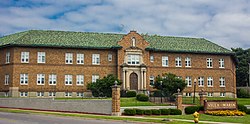
CHIJMES is a historic building complex in Singapore, which began life as a Catholic convent known as the Convent of the Holy Infant Jesus (CHIJ). The complex is located at Victoria Street in the Downtown Core, within the Central Area, Singapore's central business district.
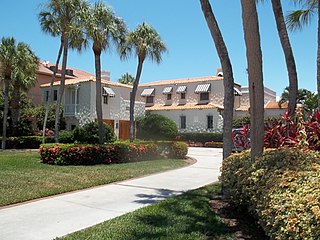
The William J. Burns House is a historic house located at 47 South Washington Drive in Sarasota, Florida. It is locally significant as an excellent example of the Mediterranean Revival style, as well as the work of local architect Thomas Reed Martin.

Dunmere is a historic estate at 560 Ocean Road in Narragansett, Rhode Island.

The Prayer Temple of Love Cathedral is located at 12375 Woodward Avenue in Highland Park, Michigan. It was built in 1929 as the Grace Evangelical Lutheran Church, and was listed on the National Register of Historic Places in 1982.

Villa Maria Motherhouse Complex, or Felician Sisters Immaculate Heart of Mary Convent Chapel and Convent, is a historic Roman Catholic convent located at Cheektowaga in Erie County, New York. It is included in the Roman Catholic Diocese of Buffalo. It was constructed in 1927, and is a three-part Gothic Revival building that was built for the Felician Sisters of St. Francis to house a boarding and day high school, public and private chapels and the Motherhouse/Novitiate. The school, known as Villa Maria Academy, closed in 2006. The school property was repurposed as affordable housing for seniors.

The U.S. Post Office-Naugatuck Main, also known as Naugatuck Main Post Office, is a historic former post office building at Church and Cedar Streets in Naugatuck, Connecticut. Designed in 1915 and completed the following year, it is one of the most architecturally sophisticated post office buildings in the state. It is set among a cluster of civic buildings designed by McKim, Meade & White. The building was listed on the National Register of Historic Places in 1986. Naugatuck's current post office is located at 170 Water Street.
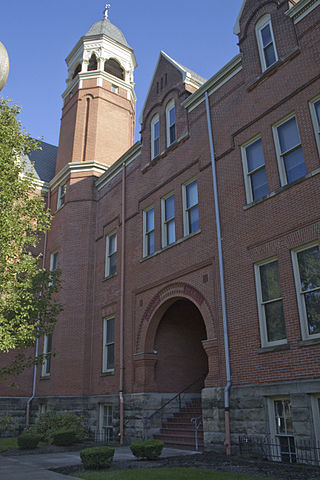
The Villa Maria Academy is a complex of two connected historic school buildings located in Erie, Erie County, Pennsylvania.

St. Michael's Catholic Church is a parish of the Catholic Church in Spalding, Nebraska, part of the Diocese of Grand Island. It is noted for its historic buildings, notably the parish church, academy, and convent, which were added to the National Register as St. Michael's Catholic Church Complex in 1983.

The Archdiocesan Shrine of Our Lady of the Assumption, commonly known as the Santa Maria Church and Santa Maria Pro-cathedral, is a Roman Catholic shrine in Santa Maria, Ilocos Sur, Philippines. The church was designated as a UNESCO World Heritage Site on December 11, 1993, as part of the Baroque Churches of the Philippines, a collection of four Baroque Spanish-era churches. It is currently the pro-cathedral of the Archdiocese of Nueva Segovia while the Vigan Cathedral is undergoing repairs.

Villa Maria Hostel is a heritage-listed nursing home at 167–173 Saint Paul's Terrace, Fortitude Valley, City of Brisbane, Queensland, Australia. It was designed by Frank Cullen, Hennessy, Hennessy, Keesing & Co, & J P Donoghue and built from 1927 to 1968. It was added to the Queensland Heritage Register on 18 September 2008.

The St. Joseph's Church Complex is a collection of historic buildings located in Fort Madison, Iowa, United States. At one time the complex housed a Catholic parish in the Diocese of Davenport. St. Joseph and St. Mary of the Assumption parishes merged in the 1990s to form Saints Mary and Joseph Parish. In 2007 when that parish merged with Sacred Heart on the west side to form Holy Family Parish, St. Joseph's Church was closed. The former church, chapel, rectory, convent, and school were included as contributing properties in the Park-to-Park Residential Historic District that was listed on the National Register of Historic Places in 2014.

All Hallows' School Buildings are a heritage-listed group of Roman Catholic private school buildings at 547 Ann Street, Fortitude Valley, City of Brisbane, Queensland, Australia. They were designed by a number of notable Brisbane architects and were constructed over many years. The earliest is the All Hallows Convent, also known as Adderton. The buildings were added to the Queensland Heritage Register on 21 October 1992.
St. Luke's School and Recreation Center is a historic building located in St. Lucas, Iowa, United States. It was listed on the National Register of Historic Places in 2005.
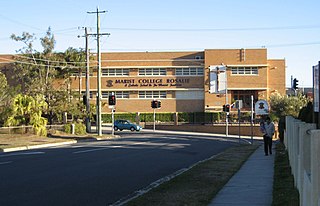
Marist Brothers College Rosalie Buildings are heritage-listed Roman Catholic monastery and school buildings at Fernberg Road, Rosalie, City of Brisbane, Queensland, Australia. They are also known as Marist Brothers' Monastery and Marist College. They were added to the Queensland Heritage Register on 18 September 2008.

The Monastery of Saint Gertrude is a Benedictine nunnery near Cottonwood, Idaho County, Idaho. Founded by three Benedictine nuns from St. Andrew's Abbey, Sarnen, Switzerland who immigrated in 1882, it was designated the motherhouse for the community in 1909. Its main building and chapel were listed on the National Register of Historic Places as St. Gertrude's Convent and Chapel in 1979.

The Arthur G. Pomeroy House is a historic house at 490 Ann Uccello Street in Hartford, Connecticut. Built in 1882 for a wealthy tobacco grower, it is a locally distinctive combination of Queen Anne and High Victorian Gothic architecture executed in brick. It was listed on the National Register of Historic Places in 1982.

The Mt. Mercy Apartments is an apartment complex for retirees, located at 1425 Bridge Street NW in Grand Rapids, Michigan. It was formerly a Catholic convent and private school known as the Mt. Mercy Academy and Convent. The building was listed on the National Register of Historic Places in 1993.

The Carpenter Building is a historic commercial building at 136 East Main Street in Gentry, Arkansas. Built in 1927–29, it is a single-story masonry structure, its exterior finished mainly in red brick and hollow clay tile. A stepped parapet obscures the flat roof, and the front facade is inset with square pier supports, giving the impression of a portico. The interior includes surviving original sections of tin ceilings. The building originally housed a retail grocery, as well as a mortuary and funeral chapel, but has since been repurposed to other uses.
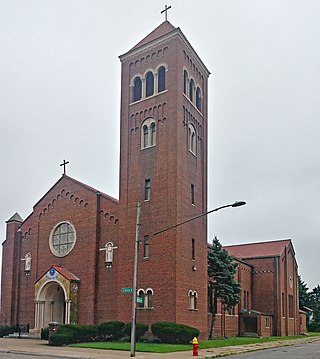
The Church of the Transfiguration Historic District is a group of buildings associated with what was the Church of the Transfiguration Roman Catholic parish, located at 5830 Simon K in Detroit, Michigan. It was listed on the National Register of Historic Places in 2019.

The Dieringer School buildings are the last remaining group associated with the Dieringer community. Constructed in 1921 and 1928 by Tacoma architect Emanuel J. Bresemann. As the community of Norwood, established on May 5, 1888, with Joseph C. Dieringer, its first postmaster. Dieringer, had a restaurant in Tacoma, before he moved to the Stuck River Valley in the 1880s. Dr. Charles H. Spinning, had been a physician in the 1860s at the Cushman Indian Agency on the Puyallup Reservation, provided the land for the Dieringer School. In 1892, the post office name was changed from Norwood to Dieringer to honor its first postmaster.
